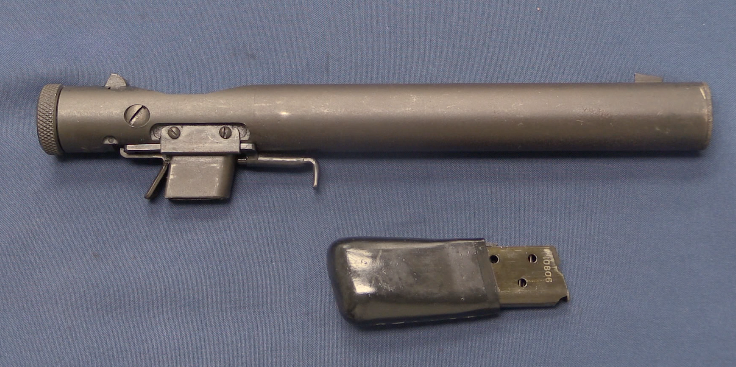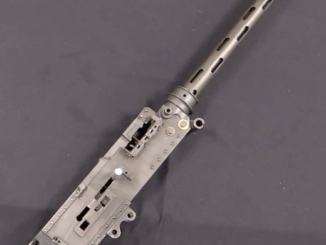While the Indian Army was looked down upon by much of the British military, it saw much more combat service than its European counterpart. The Indian Army was actually faster than the British to recognize and adopt a number of small arms improvements, and the CLLE MkI India Pattern is a good example. When the mobile charger guide was first adopted by the British military, no effort was made to retrofit earlier rifles with it.
The Indians, however, saw the advantage and began to convert Long Lees to the Charger-Loading configuration as early as 1905. Between then and 1909, some 22,000 of these MkI I.P. rifles were assembled at the Ishapore Arsenal. Following the adoption of the fixed charger bridge, a MkII I.P. became the new standard, with the fixed guide instead of the mobile one.




The British Army and Indian Army were seperate organizations
“Then in 1903, Lord Kitchener became the Commander-in-Chief of the Indian Army, his tenure continued until 1909. He instituted large-scale reforms, the greatest of which was the merger of the three armies of the Presidencies into a unified force. He formed higher level formations, eight army divisions, and brigaded Indian and British units. Following Kitchener’s reforms, terminology used for military forces in India was altered, with the Indian Army referring to “the force recruited locally and permanently based in India, together with its expatriate British officers.” Whereas the British Army in India referred to the British Army units posted to India for a tour of duty, and which would then be posted to other parts of the Empire or back to the UK. Comparatively, the term Army of India meant the combined forces of both the Indian Army and the British Army in India.”
Therefore, India could go its own way, to an extent, in terms of weapons and equipment. Probably the best example of this is the adoption of the Vickers-Berthier light machine gun in place of the Bren.
https://www.youtube.com/watch?v=NKxSkNxVVBE
A notable example of an Indian Army Officer being “not quite our sort” was the fampous author John Masters, who commanded a Chindit brigade in World War 2. “Clay speculates that Masters may have been driven to achieve by rumours that his family was not “pure” English, but Anglo-Indian or Eurasian. In 1962 Masters learned what he had apparently long suspected, that he did indeed have a distant Indian ancestor.”
https://en.wikipedia.org/wiki/John_Masters
The British Army and Indian Army were seperate organizations
“Then in 1903, Lord Kitchener became the Commander-in-Chief of the Indian Army, his tenure continued until 1909. He instituted large-scale reforms, the greatest of which was the merger of the three armies of the Presidencies into a unified force. He formed higher level formations, eight army divisions, and brigaded Indian and British units. Following Kitchener’s reforms, terminology used for military forces in India was altered, with the Indian Army referring to “the force recruited locally and permanently based in India, together with its expatriate British officers.” Whereas the British Army in India referred to the British Army units posted to India for a tour of duty, and which would then be posted to other parts of the Empire or back to the UK. Comparatively, the term Army of India meant the combined forces of both the Indian Army and the British Army in India.”
Therefore, India could go its own way, to an extent, in terms of weapons and equipment. Probably the best example of this is the adoption of the Vickers-Berthier light machine gun in place of the Bren.
https://www.youtube.com/watch?v=NKxSkNxVVBE
A notable example of an Indian Army Officer being “not quite our sort” was the famous author John Masters, who commanded a Chindit brigade in World War 2. “Clay speculates that Masters may have been driven to achieve by rumours that his family was not “pure” English, but Anglo-Indian or Eurasian. In 1962 Masters learned what he had apparently long suspected, that he did indeed have a distant Indian ancestor.”
https://en.wikipedia.org/wiki/John_Masters
As far as the “Indian [British colonial] Army v British [UK] Army, and it’s consequences for small arms, Matthew Ford’s book “Weapon of Choice” is good on this, and his PHD thesis is better.
As so often, the guys who did the fighting did the innovating. The guys who didn’t, didn’t. This is a thing, forever. Even if the fighting guys don’t get the right answer, they at least ask the question. The guys who don’t fight just carry on polishing their boots and practicing their drill. See also: naval gunnery 1900-1916.
No surprise that actual fighting men were the ones pushing for better stuff and finding out that bureaucrats make horrible armorers.
Ian, awesome. Thanks.
The rifle shown is marked “M&D” above the Enfield roundel on the stock, showing that it is an ex-Canadian rifle, surplussed off when Canada switched to the Ross rifle. There’s no case to make that the “Indian Amry” was quicker on the uptake than the British Army. The Indian part of the Indian Army; ie: non-British officers & men generally received weapons that were a bit out of date or not so capable as what the British Army received. Not only because they were not fully trusted after the Indian Mutiny, but just for reasons of economy. So converting the older rifles was naturally done first in India since they were only going to get the new SMLE after the British Army was fully equipped, and maybe not even then. As for tea and crumpets, as a Canadian Ian should know better than to make such silly remarks. Officers were expected even into the 1930s to have “private means” as their pay was barely enough to live on. Officers who were short of money often chose the Indian Army as living costs there were far lower than in the British Army “at home” or in other parts of the Empire. The other type that chose the Indian Army was those who fancied an easy life of sport, servants and long leaves, so if anyone was taking it easy it was the officers in India. The climate however was a killer, especially of children; another reason they were usually “sent home” at an early age.